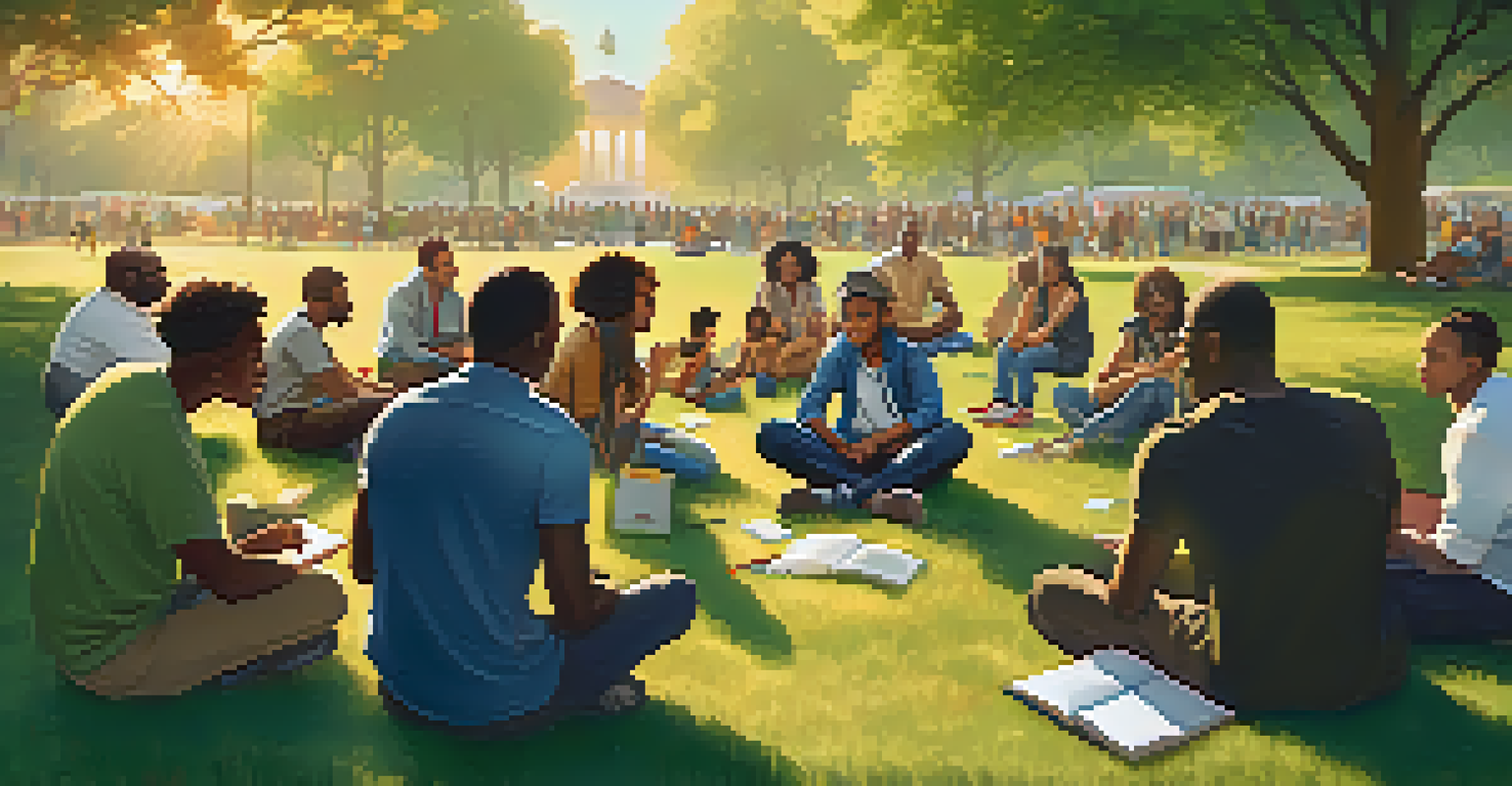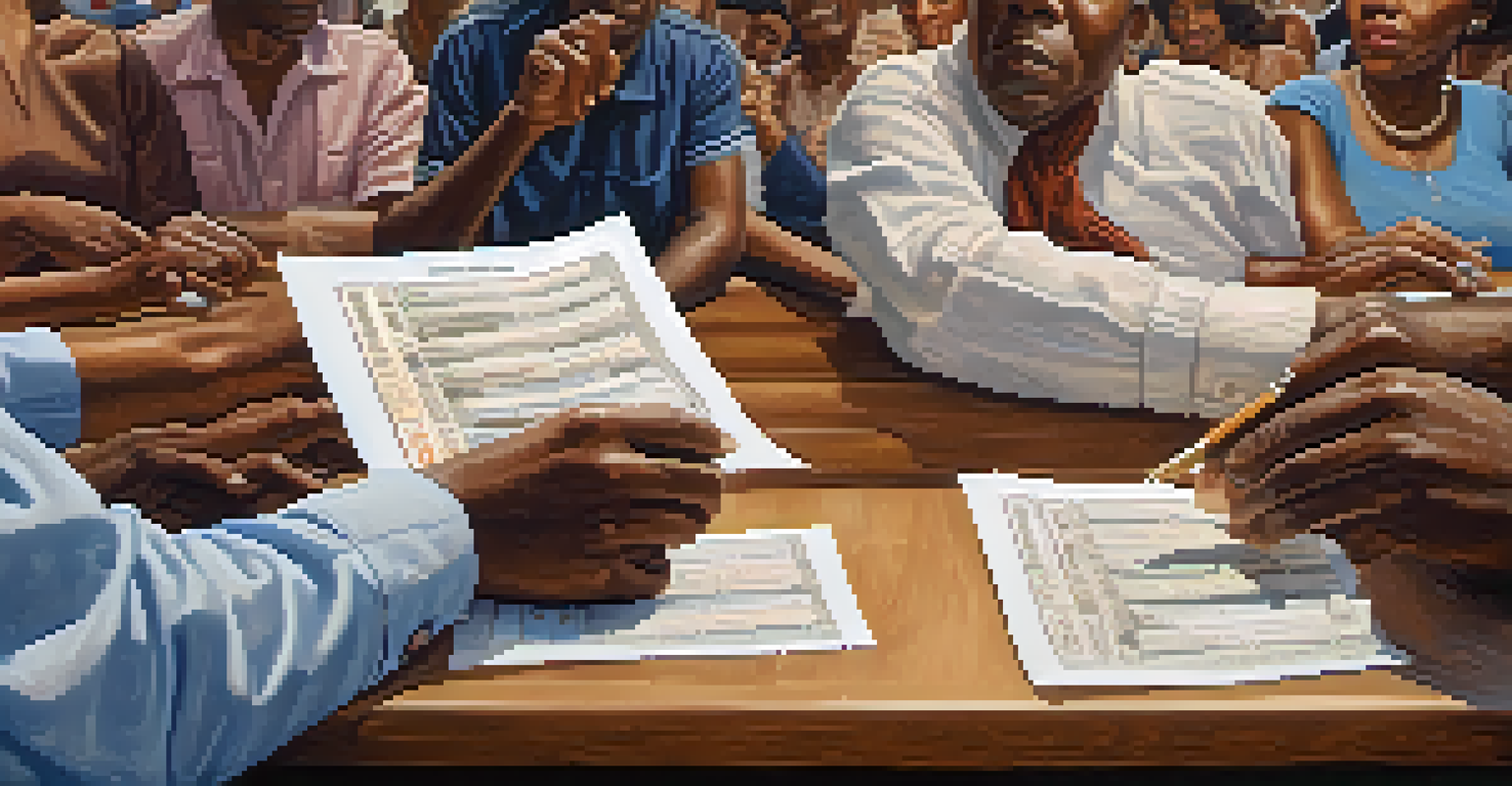Compton's Role in the Watts Riots and Civil Rights

Understanding the Watts Riots: A Catalyst for Change
The Watts Riots, which erupted in August 1965, were a response to deep-seated racial tensions in Los Angeles. Sparked by an altercation between police and a Black motorist, the riots lasted for six days, leaving a community in turmoil. This event was not just a spontaneous explosion of anger; it highlighted systemic issues of poverty, discrimination, and police brutality that had been simmering for years.
Injustice anywhere is a threat to justice everywhere.
Compton, located just a few miles from Watts, was significantly affected by the riots. Many residents of Compton empathized with the struggle faced by their neighbors, as they too dealt with similar injustices. The riots served as a wake-up call, urging citizens to confront the harsh realities of their environment and fight for civil rights.
The aftermath of the Watts Riots saw a surge in activism, not only in Watts but also in surrounding areas like Compton. Community leaders began to organize efforts aimed at addressing the underlying issues that led to the riots, including poverty, education, and housing discrimination. This collective effort was essential in fostering a sense of unity and purpose within the community.
Compton's Community Response to Racial Injustice
In the wake of the Watts Riots, Compton residents mobilized to address racial injustice through various community initiatives. Organizations were formed to advocate for better education, housing, and job opportunities for African Americans. These grassroots movements were essential in promoting the message that change could be achieved through collective efforts.

Local leaders emerged, bringing together community members to engage in dialogue about their rights and the necessary steps to achieve equality. Meetings became a platform for sharing experiences, educating one another, and strategizing on how to tackle local issues. This sense of community empowerment was crucial in transforming Compton into a focal point for civil rights activism.
Watts Riots Sparked Community Action
The Watts Riots highlighted systemic racial injustices and galvanized community efforts in Compton to address issues like poverty and discrimination.
The solidarity displayed by Compton residents during this period reflected a broader trend across the nation. Many communities witnessing similar injustices began to organize and demand change, reinforcing the idea that collective action was vital in the fight for civil rights. Compton's experience served as a microcosm of the larger movement sweeping across the United States.
Key Figures in Compton's Civil Rights Movement
Several influential figures emerged from Compton during the civil rights era, playing pivotal roles in advocating for change. Activists like the late Congressman Walter R. Tucker III, who fought tirelessly for social justice, became symbols of hope and resilience. Their leadership inspired many in the community to take action and pursue equality.
The only way to deal with injustice is to confront it head on.
These leaders didn't just focus on high-profile activism; they also emphasized the importance of grassroots organizing. They worked tirelessly to educate their neighbors about voter registration, civil rights laws, and the significance of local governance. This focus on education ensured that the community was informed and empowered.
Moreover, the involvement of local churches and organizations added to the momentum of the civil rights movement in Compton. These institutions became safe havens for discussions and planning, allowing community members to strategize how best to advocate for their rights. The synergy between community leaders and local organizations was instrumental in driving change.
The Role of Education in Promoting Civil Rights
Education played a crucial role in Compton's response to the civil rights movement. Local schools became centers for political awareness, where students learned about their rights and the importance of civic engagement. This newfound knowledge empowered young people to become advocates for their communities.
In addition, community leaders pushed for improvements in educational resources, recognizing that equal access to quality education was essential for progress. They organized meetings and rallies to demand better funding and facilities for schools in predominantly Black neighborhoods. This focus on education laid a foundation for future generations to continue the fight for equality.
Education Fuels Civil Rights Advocacy
Local schools and community programs in Compton played a vital role in empowering residents through education about their rights and civic engagement.
The impact of education extended beyond the classroom, as community programs emerged to teach residents about their rights. Workshops and seminars became common, providing valuable information on legal rights, voting, and social issues. As a result, a more informed populace began to rise, ready to challenge the status quo.
Cultural Expression as a Form of Resistance
Art and culture have always been powerful tools of resistance, and Compton was no exception during the civil rights movement. Musicians, poets, and artists began to use their crafts to express the frustrations and aspirations of the community. This cultural expression not only elevated local voices but also served as a rallying cry for change.
The vibrant art scene in Compton became a source of pride and empowerment, allowing residents to share their stories and experiences. Murals depicting struggles and victories adorned the streets, reminding everyone of the resilience and strength of the community. This artistic movement fostered a sense of unity and identity among residents.
Moreover, cultural events and performances became platforms for raising awareness about civil rights issues. These gatherings drew in large crowds, creating spaces for dialogue and activism. By blending art with advocacy, Compton's residents effectively communicated their message and garnered support for their cause.
Challenges Faced by Compton's Activists
Despite the passion and determination of activists in Compton, they faced numerous challenges in their pursuit of civil rights. Resistance from local authorities and systemic obstacles often hindered their efforts. Many activists were met with hostility, making it difficult to organize and execute their initiatives.
Additionally, internal divisions within the community sometimes posed obstacles to progress. Differing opinions on strategies and priorities led to debates and disagreements among activists. Nonetheless, these discussions often yielded new ideas and perspectives, contributing to a more comprehensive approach to advocacy.
Cultural Expression as Resistance
Artists and musicians in Compton used their crafts to voice community struggles and aspirations, creating a vibrant culture of resistance during the civil rights movement.
Despite these challenges, Compton's activists remained resolute. Their resilience in the face of adversity showcased their commitment to the cause. Each obstacle became an opportunity to strengthen their resolve and deepen their connections within the community.
Compton's Legacy in the Civil Rights Movement
The legacy of Compton's involvement in the civil rights movement continues to resonate today. The community's efforts laid the groundwork for ongoing advocacy and activism in the area. Many of the leaders and organizations established during this time have evolved, continuing to fight for justice and equality.
Moreover, the spirit of solidarity and activism remains strong among Compton's residents. The lessons learned during the civil rights era serve as a reminder of the importance of community engagement and collective action. Today's activists often draw inspiration from the past as they work to address contemporary issues.

As Compton evolves, its history during the civil rights movement remains a crucial chapter. It serves as a testament to the power of community, resilience, and the relentless pursuit of justice. The story of Compton is not just one of struggle; it's also a story of hope and empowerment that continues to inspire future generations.